You built something amazing. Your product. Your baby.
Now comes the hard part—selling it.
Luckily, it’s 2025, and AI is your secret weapon. No awkward sales calls, no chasing leads. Just a killer email sequence that works while you sleep.
Ry Schwartz helped Amy Porterfield pull in $500K with a few well-timed emails. You can do the same.
No big email list yet? Check out how I tripled mine in 3 months.
Already got subscribers? Time to turn them into customers on autopilot. All you need:
- A simple email sequence
- The right tools to send at the perfect time
- The right words (that’s where this guide comes in)
Here is a 4 steps process of how to write a sales email sequence and 16 battle-tested email sequences to steal, tweak, and use. Let’s go!
If you’d like to jump to a specific section be my guest use the table of contents or just read along like you normally would! It’s a good read.
- 4 Steps to Writing a Killer Sales Email Sequence
- The Structure of a High-Converting Sales Email
- 1. Get Into the Inbox (Or Get Ignored)
- 2. Define the Goal (What Action Do You Want?)
- 3. Nail the Hook (Make Them Read)
- 4. The Body (Make Them Want It Now)
- Important copy and style tips for writing high converting sales emails
- What to say in your first welcome sales email to new subscribers
- Creating a series of sales emails to put into an automated sequence
- Final thoughts
4 Steps to Writing a Killer Sales Email Sequence
1. Who – Identify & Target
Knowing who you’re talking to is the foundation of any great sales email. Whether it’s a warm subscriber, a past customer, or someone already familiar with your brand, your email should feel personal and targeted. Think of it like talking to a friend rather than a stranger.
Example:
In this HubSpot blog post, they share an email example that tailors the message based on the recipient’s past experience:
“Hey [Name], I saw you recently downloaded our guide on increasing your website traffic. How’s the process going? If you’re looking for more detailed insights, I’d love to offer you a free consultation to see how we can help you grow even faster.”
This approach directly speaks to the recipient’s interests, showing you know who they are and what they need.
2. Why It Matters (The Value)
Once you’ve captured their attention, show them how your product solves their problem. Share a quick story or use proof to make them think, “This is exactly what I need.” Relevance is key—don’t just talk about your product, talk about how it makes their life easier or better.
Example:
In this Shopify article they share an email that explains how a fitness brand’s products improve the reader’s journey. It focuses on solving a specific pain point:
“Hey [Name], we know finding the right workout gear can be a hassle. That’s why our new ActiveFit leggings are designed to provide maximum comfort and durability for even the toughest workouts. And, we’re offering a 10% discount just for you—because we know how important comfort is to reaching your fitness goals.”
This email shows how the product adds value to the recipient’s life, focusing on a specific problem and offering a solution.
3. The Offer (What’s Next?)
Introduce your product, service, or special deal. Keep it clear and concise, with a sense of urgency. Let them know why they should act now. A great offer often includes social proof, testimonials, or a sense of scarcity to make it irresistible.
Example:
In this Neil Patel blog post, he suggests using urgency in the offer like this:
“Hi [Name], we’re offering an exclusive 25% discount on our premium SEO services for the next 48 hours. Hundreds of businesses have already benefited from our strategies, and we’re confident that we can help you achieve similar results. Don’t miss out—secure your spot today!”
This email not only promotes the product but also uses a deadline to push the reader to act quickly.
Here is a love example from his own website:

4. The Call to Action (Make It Easy)
A strong call to action (CTA) is crucial. Tell your reader exactly what to do next—whether it’s clicking a link, booking a call, or grabbing a special offer. Make it simple, clear, and hard to ignore.
Example:
In this ActiveCampaign blog post, they offer a direct CTA that leaves no room for confusion:
“Click here to schedule your free consultation. Let’s get started on improving your email marketing strategy today.”
The CTA is clear, actionable, and directs the recipient to the next step without overcomplicating things.
Know your audience, speak their language, and let your emails do the heavy lifting for you.
The Structure of a High-Converting Sales Email
1. Get Into the Inbox (Or Get Ignored)
Before anything else, make sure your emails actually reach your audience.
Ensuring your sales emails reach recipients’ inboxes is crucial for effective engagement. To assess and enhance your email deliverability, consider using the following tools:
- MxToolbox Email Deliverability Tool – Analyzes email headers, checks blacklist status, and verifies SPF records for a comprehensive deliverability report.
- GMass’s Spam Solver – Allows you to test emails, make adjustments, and retest to ensure they land in the inbox.
- Mail-Tester – Evaluates your email by sending it to a test address, checking against spam filters, and providing a score with improvement suggestions.
- GlockApps – Offers insights into email deliverability, including spam score checks, authentication validation, and blacklist monitoring.
- Unspam.email – Tests your email deliverability across various platforms, optimizing for Gmail, Outlook, Yahoo, and more.
Steps to Test Your Email Deliverability:
- Choose a Tool – Pick one that fits your needs.
- Send a Test Email – Follow the tool’s instructions, usually sending a test email to a provided address.
- Review the Report – Check feedback on spam score, authentication issues, and blacklist status.
- Implement Recommendations – Adjust email content, authentication settings, or sending practices as needed.
Regularly testing and refining your email strategies with these tools can significantly boost deliverability rates, ensuring your messages reach and engage your audience.Tip: Use a verified email address with a DMARC policy. If they subscribed via yourwebsite.com, send emails from name@yourwebsite.com. Unverified emails = straight to spam. This alone boosts deliverability 10X.
2. Define the Goal (What Action Do You Want?)
Before writing the sales sequwnce, get clear on what you want them to do:
- Click a link?
- Reply to your email?
- Sign up for your SaaS product?
- Book a call?
Your Call to Action (CTA) is the anchor of your email. If you want them to book a call, make it seamless—just like Neil Patel does in his sequences, where every email leads to a calendar link.
3. Nail the Hook (Make Them Read)
Your first lines decide everything—boring intros kill response rates. Instead, use:
Story-Driven Hooks
Example: James Kemp hooks readers with a personal, unexpected story:
“Yesterday, I went on a school trip with my 5-year-old. 36 little humans. Me and six moms. As predicted, I was the only dad. But here’s what I learned from an 800kg crocodile named Scar…”
By the end, he seamlessly connects this story to eCommerce success.
uriosity-Driven Hooks
Example: Joanna Wiebe of Copy Hackers starts out all her sales emails with:
“Don Draper. This is for you, you cunning trickster. We used to be friends. At least to the degree that one can fall in love with a fictional antihero…”
No mention of her offer yet—just pure intrigue. She later ties it to a mastermind for copywriters drowning in self-doubt.
4. The Body (Make Them Want It Now)
Use psychological triggers to build urgency and desire:
FOMO & Scarcity – “Only 3 spots left—once they’re gone, they’re gone!”
Social Proof – “5,000+ marketers have already joined.”
Authority – “Taught by experts featured in Forbes & HubSpot.”
Example of a High-Performing Sales Email:
Misty Megia uses urgency + FOMO to sell Ben’s course:
Hey [Name],
Ben’s course closes in 24 hours. And after that? It’s gone for good.
Last time, 3 people emailed me begging for a spot after the deadline. Don’t be that person.
Join here before it’s too late: [Link]
Key Takeaway: Great sales emails feel personal, engaging, and urgent. Know your goal, hook them fast, and use psychology to drive action.
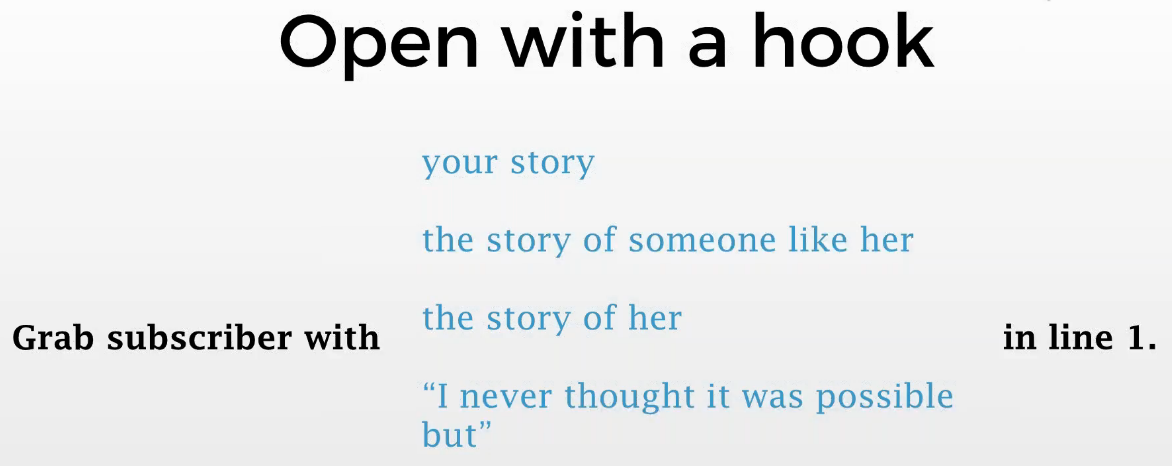
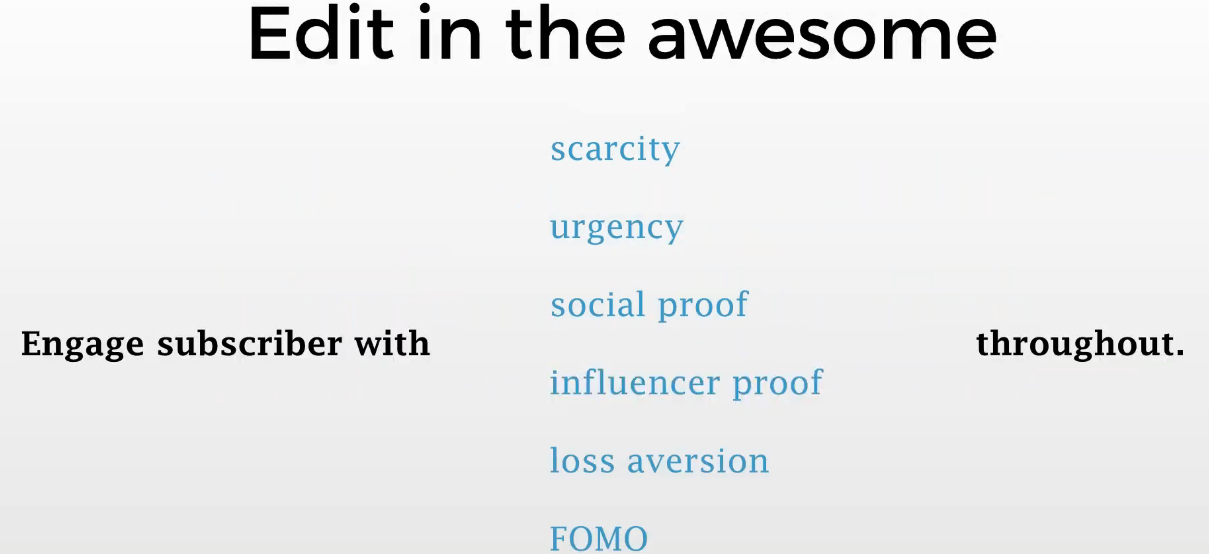
Here’s an example of highly effective sales email sequence where Misty uses urgency and FOMO to sell Ben’s course:
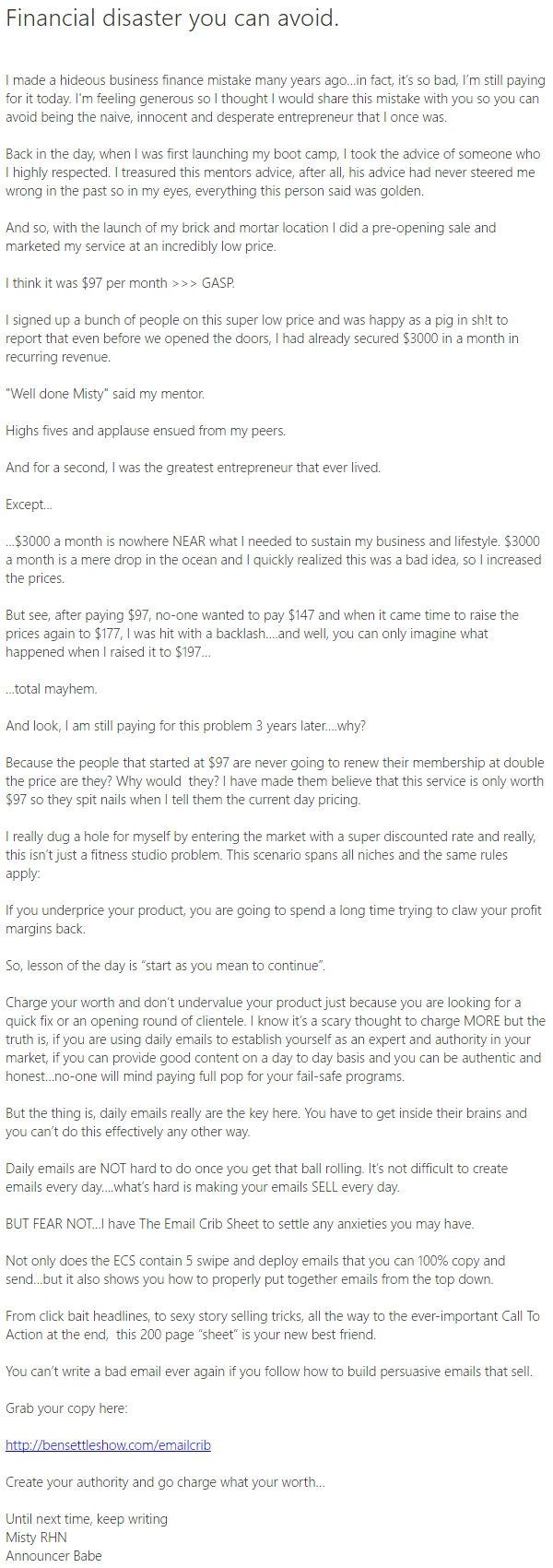
Important copy and style tips for writing high converting sales emails
A. Every new sentence should start on its own line.
Example:
I’m the founder of JustReachOut ‘” helping entrepreneurs forget PR firms and pitch press on their own.
I am a contributor for Entrepreneur, TheNextWeb and TechCrunch.
I’ve also written for Mashable, Huffington Post, WIRED and many others.
Why? According to a May 2016 Litmus study, 54% of recipients open emails on their mobile phones. So even by including as little as 2-3 sentences in a single block, it looks like a lot to read on a small screen.
B. Don’t use a call to action until your copy has made your audience ready for it.
Your copy has to educate, entertain and emotionally stir your prospects on the benefits of taking action before you can ask them to do it. Ask too early and you may get the reaction: “Why should I?” Then they may check out of your sales email entirely.
This means that in many cases if you want a high conversion rate, you should only place CTAs at the end of your emails. I would also use a conversion rate tool to measure and optimize the conversion so that you have data on which CTAs are converting better vs. others. Here’s an example of a recent sales email Joanna from Copy Hackers sent. She told a long story before asking readers to take action (click on a link) at the end:
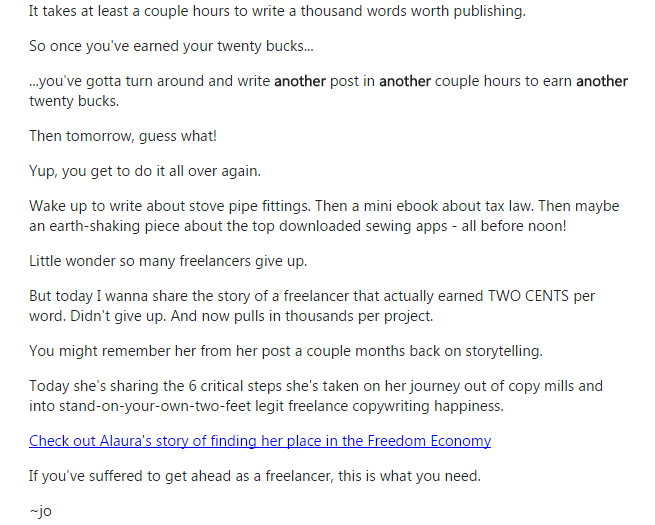
C. Don’t ask your audience questions they may answer no to.
When posing questions related to the value of your product or the importance of taking a specific action, make sure you only ask ones you can be confident most of your audience would say yes to. When in doubt, avoid phrasing your point as a question. When your audience mentally disagrees with something, they subconsciously become less receptive to everything you say afterwards.
Instead of saying: “Doesn’t it suck to forget a few important steps during product launch?”, you can rephrase it into a statement like: “When launching a product, it’s easy to forget a few important steps that come back to bite you later.”
Here’s an example of a sales email Ryan Levesque sent inviting his subscribes to a Q&A call with him. Notice how the only questions he asks are ones related to whether or not one can attend his call. He doesn’t ask any questions related to the value subscribers would get out of attending it.
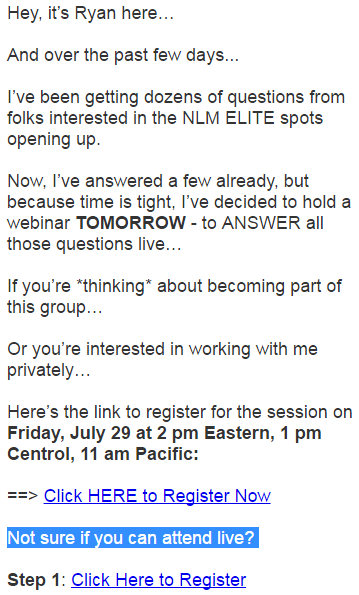
D. Don’t ask your audience to take more than one action in one sales email.
The paradox of choice. The more choices you give your audience, the less likely they are to take any action at all because now it’s that much more work for them to decide between all these options. Focusing on one action you want your subscriber to take will also make your copy that much more powerful because it won’t have to connect the dots between separate topics.
Here’s an example. See how Marie doesn’t ask subscribers to take any other action except watch her video and leave a comment?
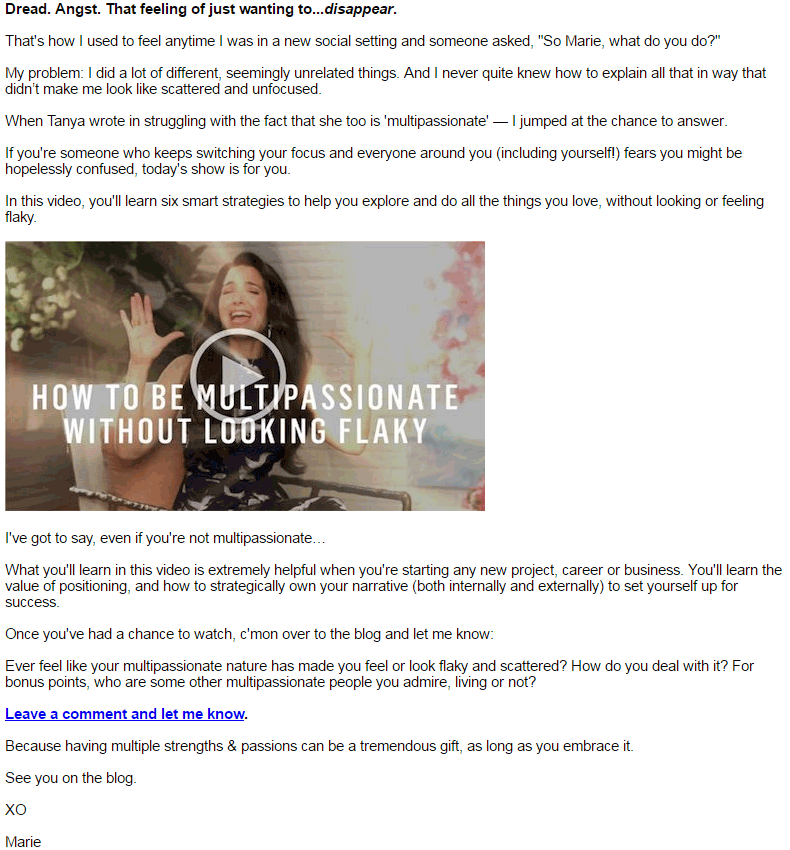
Pro tip: Check your triggered emails. Sometimes when you send out emails you setup something called triggered emails which are sent when a specific action occurs such as someone subscribed to your list by clicking over your website from social media. In that case the sales engagement platform sends out an automatic triggered email. You might forget about this triggered email and send your sales sequence in addition to it. This will confuse the recipient even more.
What to say in your first welcome sales email to new subscribers
A. If you sell content based products (example: courses, masterminds, etc.)
Your welcome should should include:
- Welcome your subscribers to the community
- Get them excited about the type of content they can expect from you in the future
- If you cover diferrent topics, you can ask your new subscribers which one they’re most interested in
For example, if your site focuses on digital marketing, you can ask your subscribers to click on the topic they’re most interested in receiving:
- SEO
- Content marketing
- Facebook ads
In your email marketing platform, set up a rule so that depending on which link a subscriber clicks inside this email, they’re automatically added to a new list.
For example, if they click on SEO, they can be automatically added to a list called ‘Subscribers interested in SEO’. Then in the future, if you plan to send a sales mail about SEO, you can send it only to that list instead of the general list containing all your readers.
This keeps the content you sent out interesting for all different types of subscribers so they keep opening and reading your future emails. This gives you more chances to gain their trust in your product value.
Here’s another example showing how Brian Dean asks new subscribers to click on the topic they’re most interested in in his welcome email:
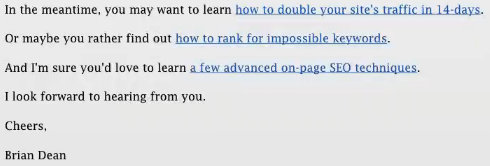
B. If you sell a SaaS product
Your welcome sales email should include:
– Thank new users for trying your product
– Ask them why they decided to give your product a try
This way you can get valuable feedback about the problems your users are trying to solve and the goals they want to achieve related to your product. So you know which product features you should spend more time developing and how to better frame your product value to future users.
Make sure your welcome email is written as a really personal message from the founder of the company. This way, it’s easier for new users to connect with and trust your company, knowing there’s good people working behind the scenes.
This is how Stuart McKeown welcomes new users to his tool Gleam:
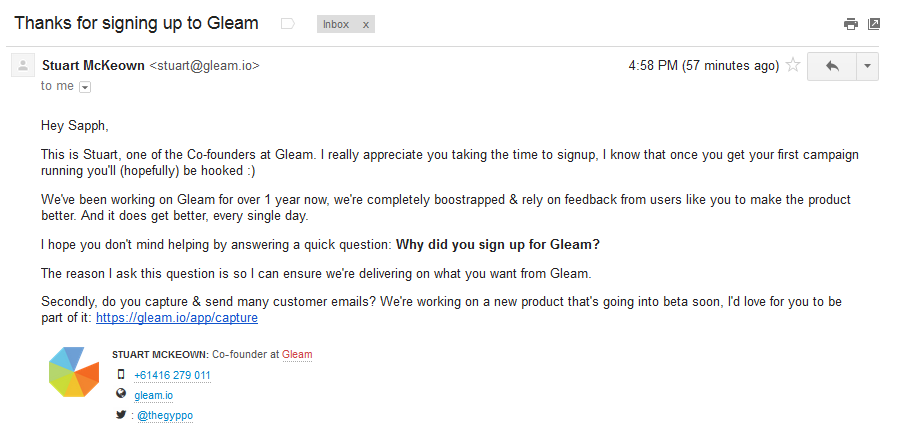
Creating a series of sales emails to put into an automated sequence
When launching a product to existing subscribers or nurturing new subscribers to buy your existing products, you can send a series of emails to convince them to eventually buy. This is much more effective than simply asking for the sale within a single point of contact since you get several chances to explain your product’s benefits, to address prospect objections and to share success stories.
To create compelling sales sequence emails, think about what type of customers gravitate toward your product.
Example of customer personas:
- Would they a skeptic (will your product work for me)?
- Would they be a number cruncher (how will your product help me save money or make money)?
- Would they be a dreamer (how will your product help me achieve my aspirational lifestyle)?
Then consider the thought process these customers typically go through before deciding to buy your product. In each email in your sales sequence, focus on addressing a specific thought or objection your prospect would likely have.
For example, let’s say you sell emails tracking tool and your customer persona is skeptic.
A sales sequence that addresses prospects’ thought process could look like:
A. Prospect thought: I have no clue what’s happening to my emails after I click send. Did the other person read it? Did the other person click on any of its links?
Email #1: Talk about how easily and effectively your product solves these problems.
For example: Never wonder again what’s happening on the other side. See exactly when your prospect opened your email, where they did and how many times they did. Like you’re looking over their shoulders!
B. Prospect thought: Finally, I know if my emails are being read and how many times they’ve been read. But what do I do with this info?
Email #2: Provide specific examples showing how they can use your product to achieve their goals.
Let’s look at an example: Saw that someone opened your email a few times but never responded? Chances are they were interested in what you had to say but got too busy to reply. You can send a short follow up email to get back on their radar.
C. Prospect thought: Ok cool, but does this actually make my life significantly easier?
Email #3: Describe a few of the biggest time saving headache reducing benefits the prospect will get from using your product.
Example: With email tracking, you’ll be able to see what subject lines and email content consistently get opens and replies. Then you can turn those into proven templates to use again and again.
D. Prospect thought: Yeah but why should I buy right now?
Email #4: Provide an incentive for your prospect to buy right now.
Example: By upgrading today, you get 10% off our yearly plans. And one of our copywriters will help you rewrite a few of the emails you send often to get more opens and replies!
This is an example of how you can plan out your prospect thought process to write your sales sequence emails:
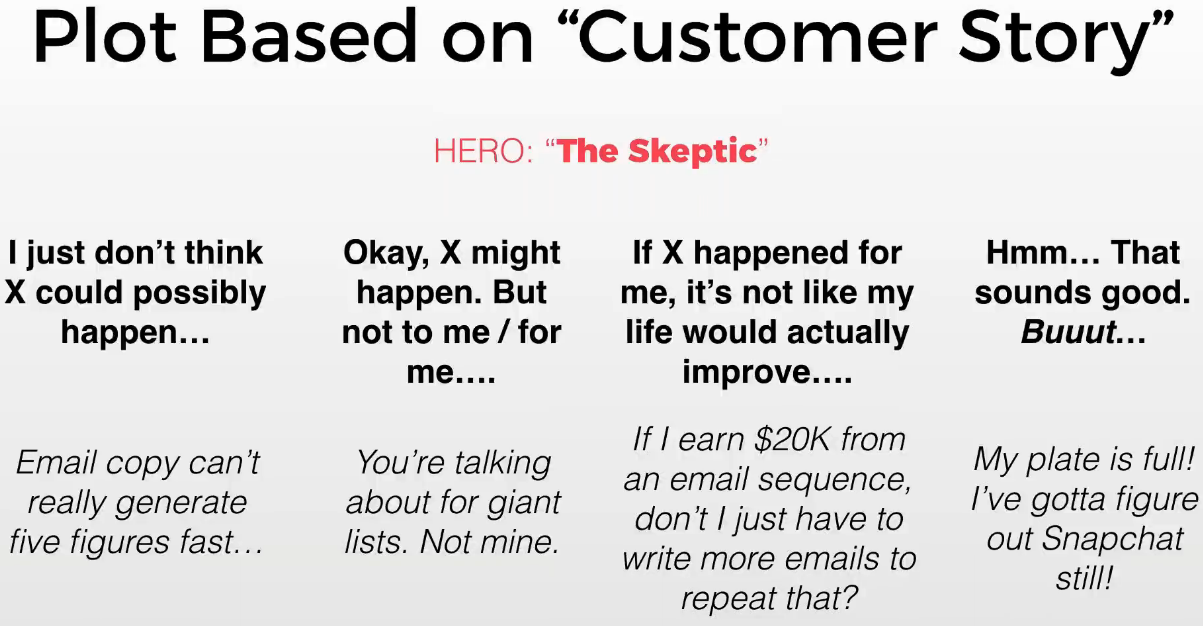
Here’s the full sales sequence emails cycle Bryan Harris of Videofruit sent me about his “$10 000 in 24 hours” course:
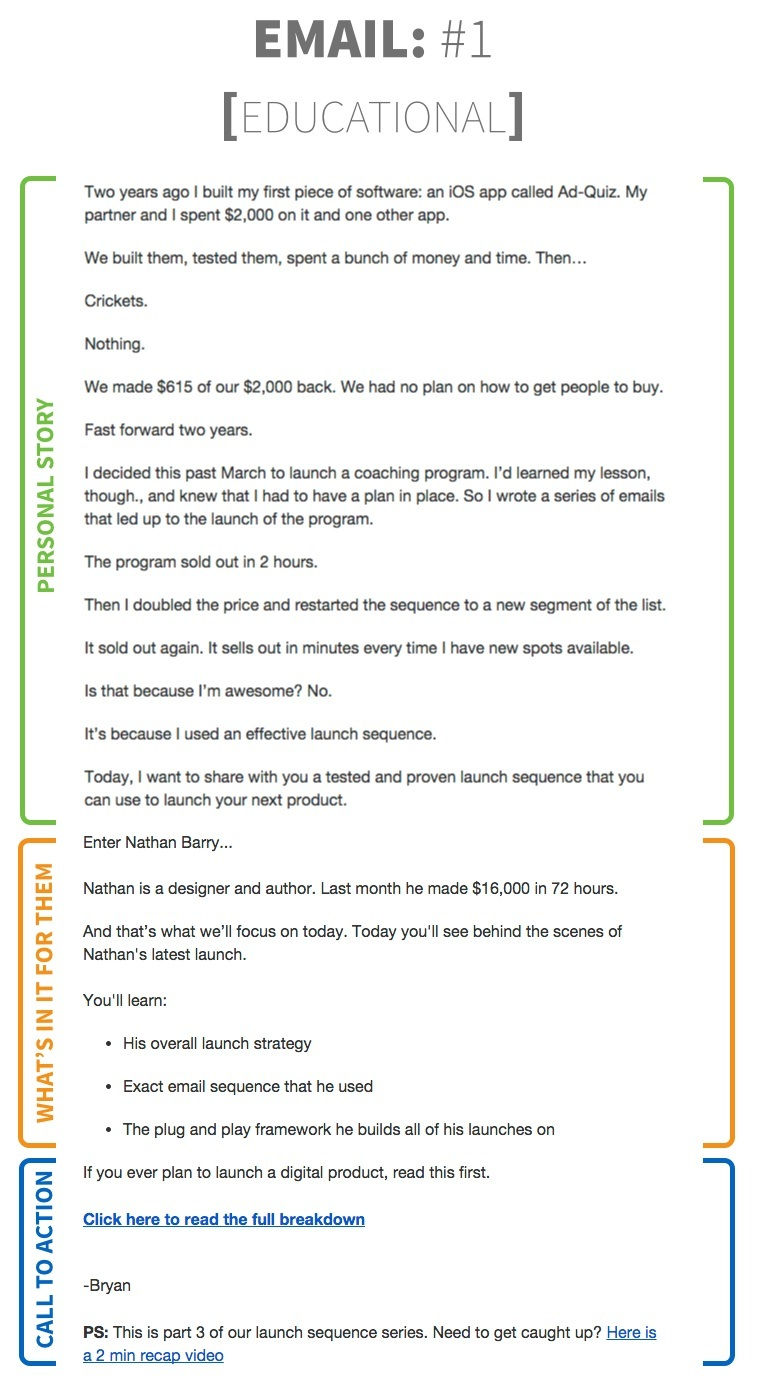
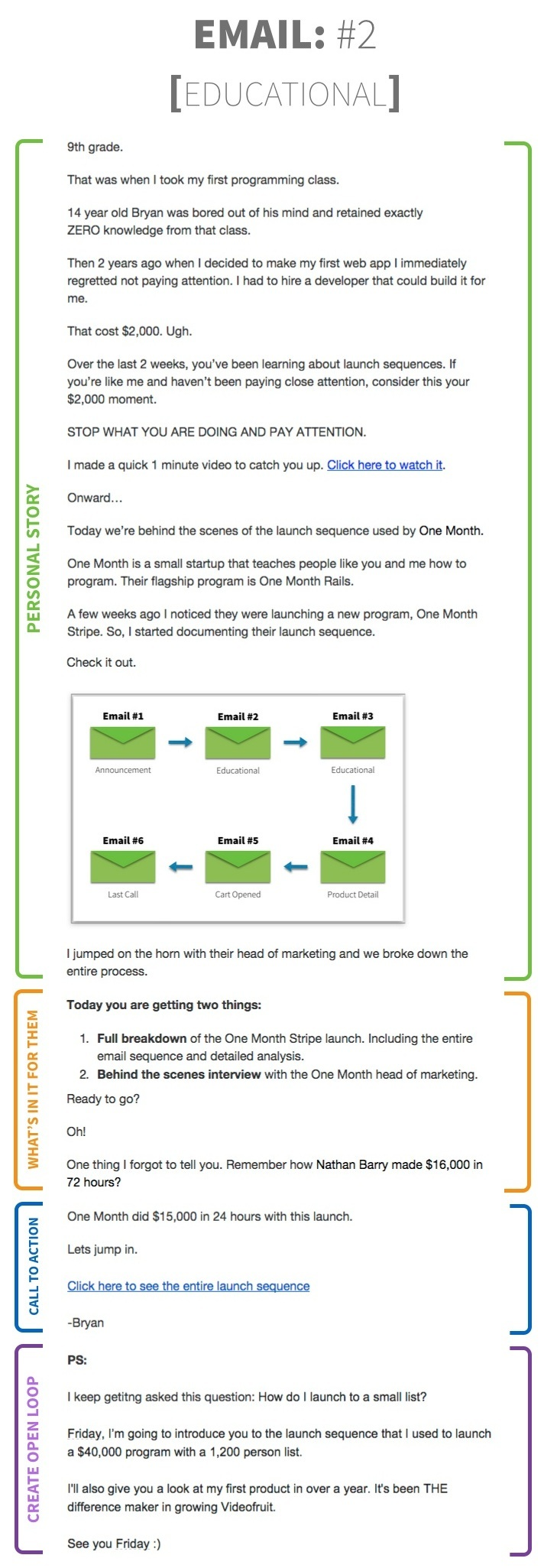
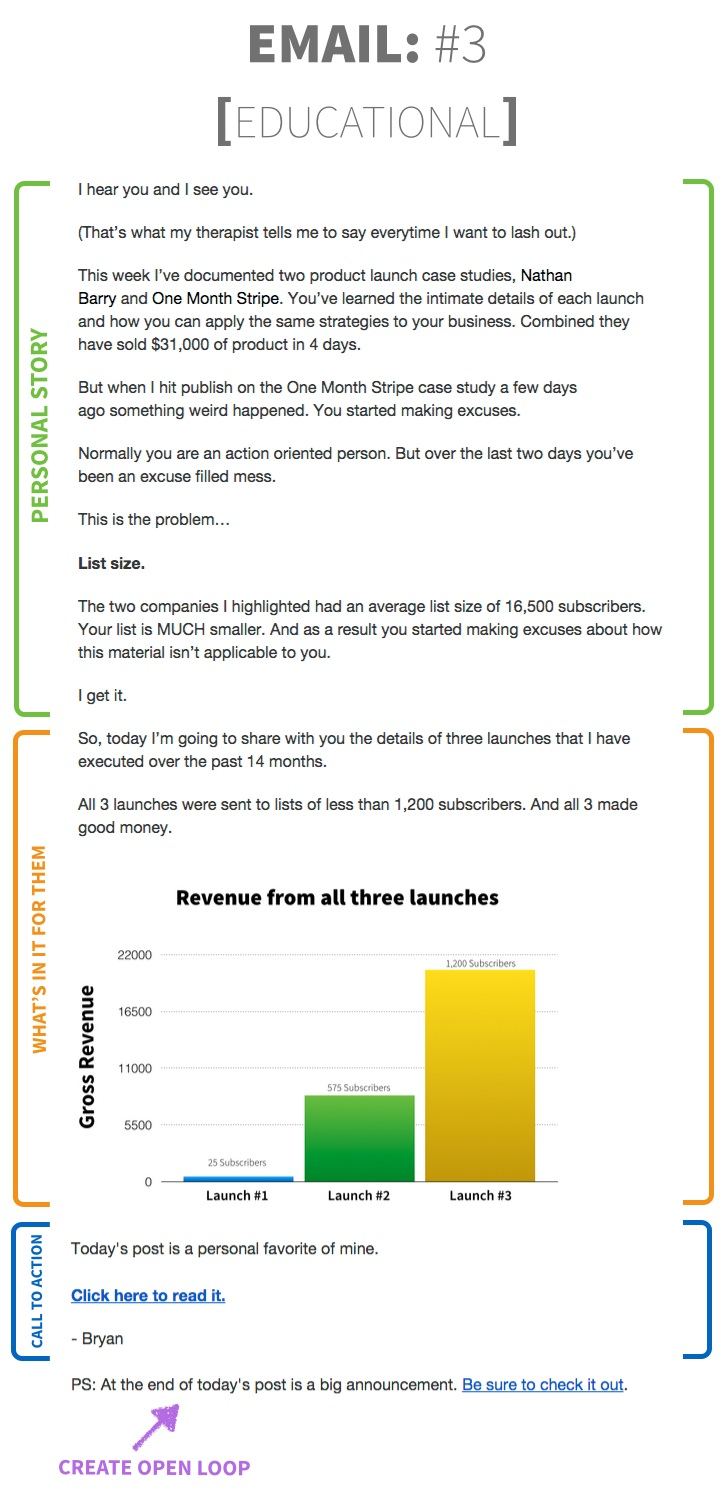
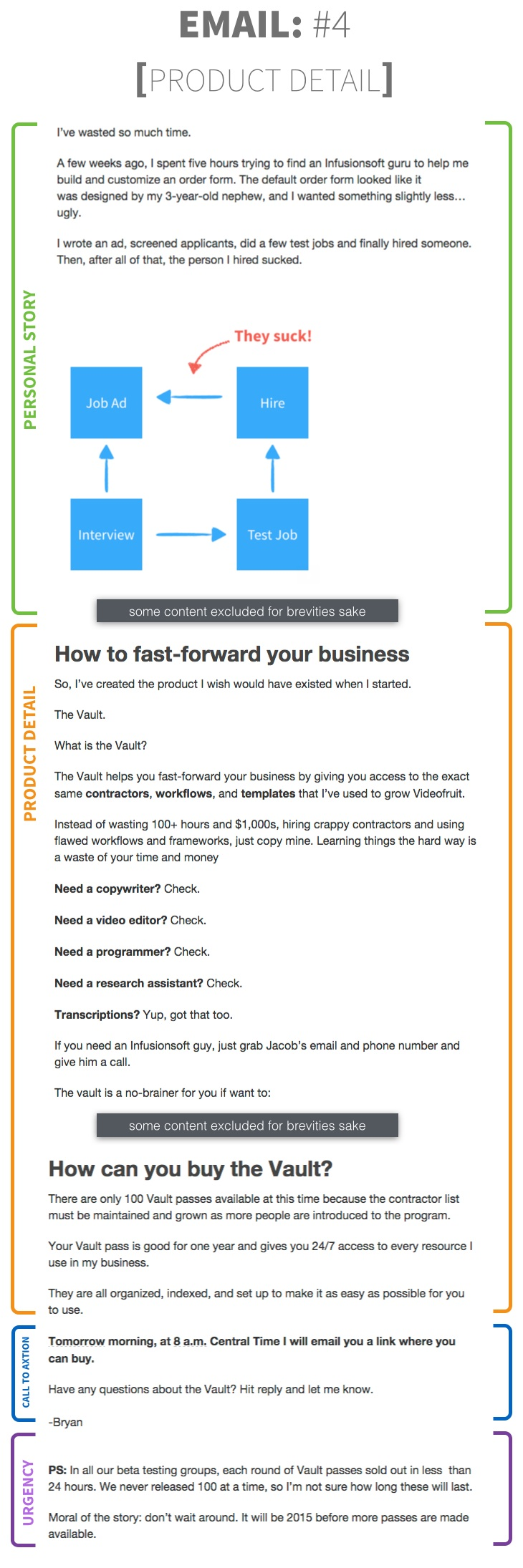
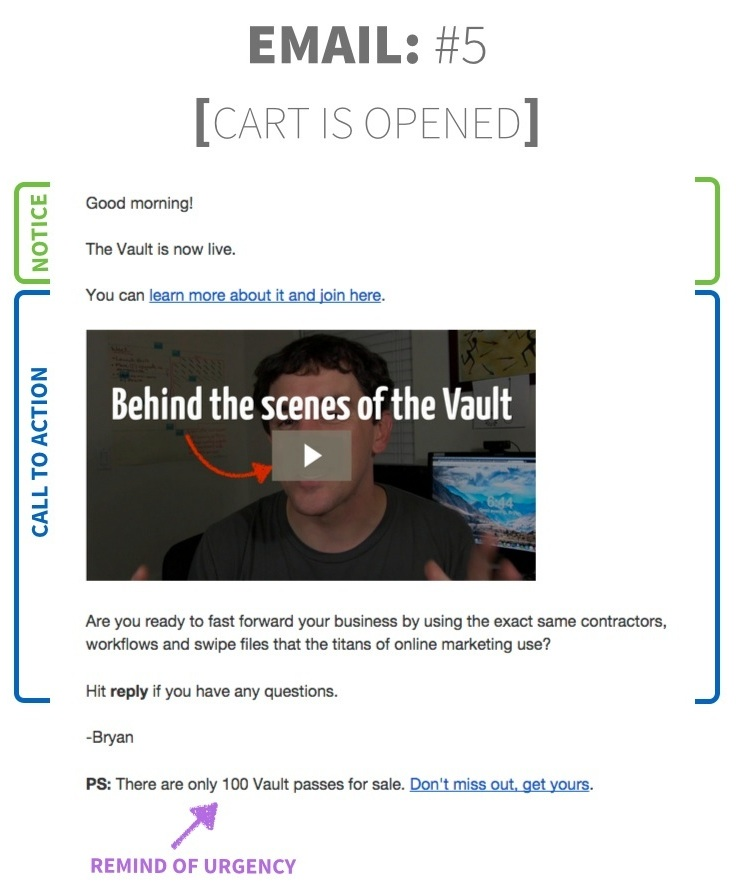
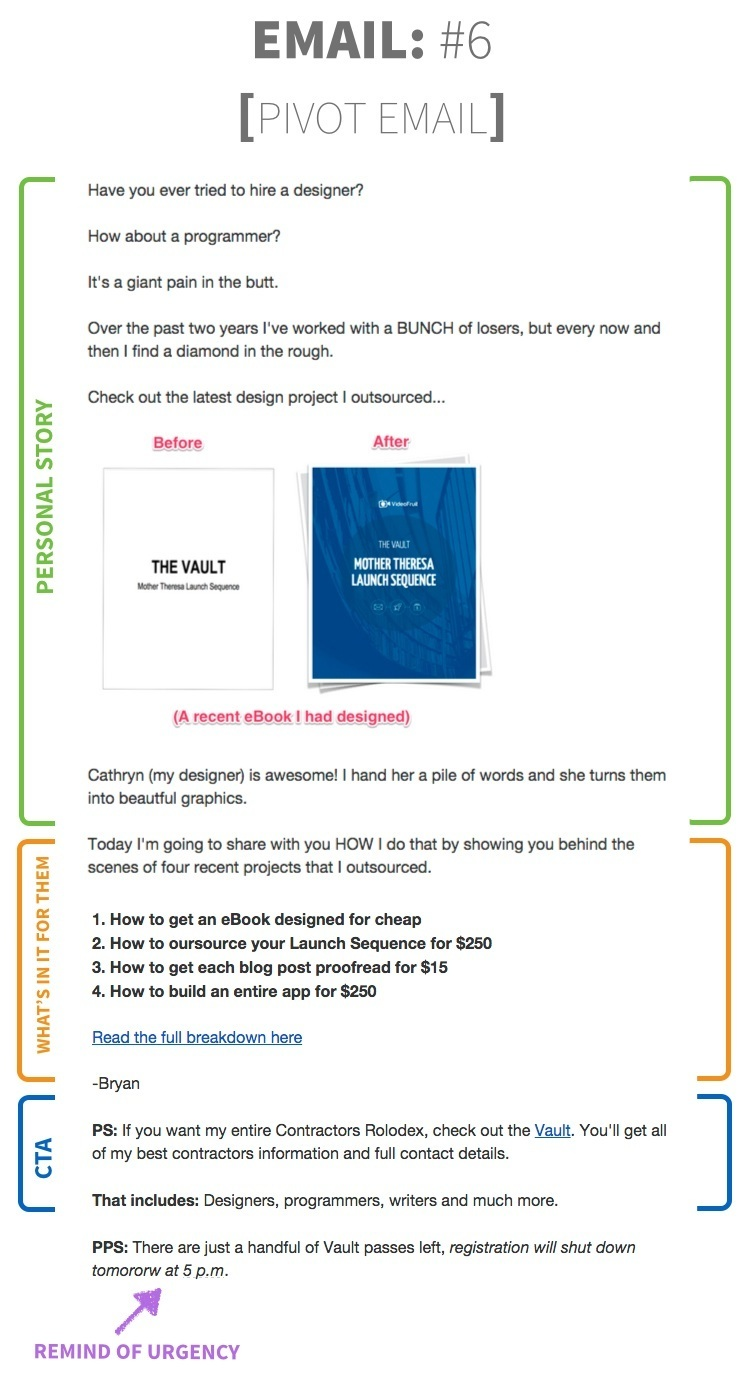
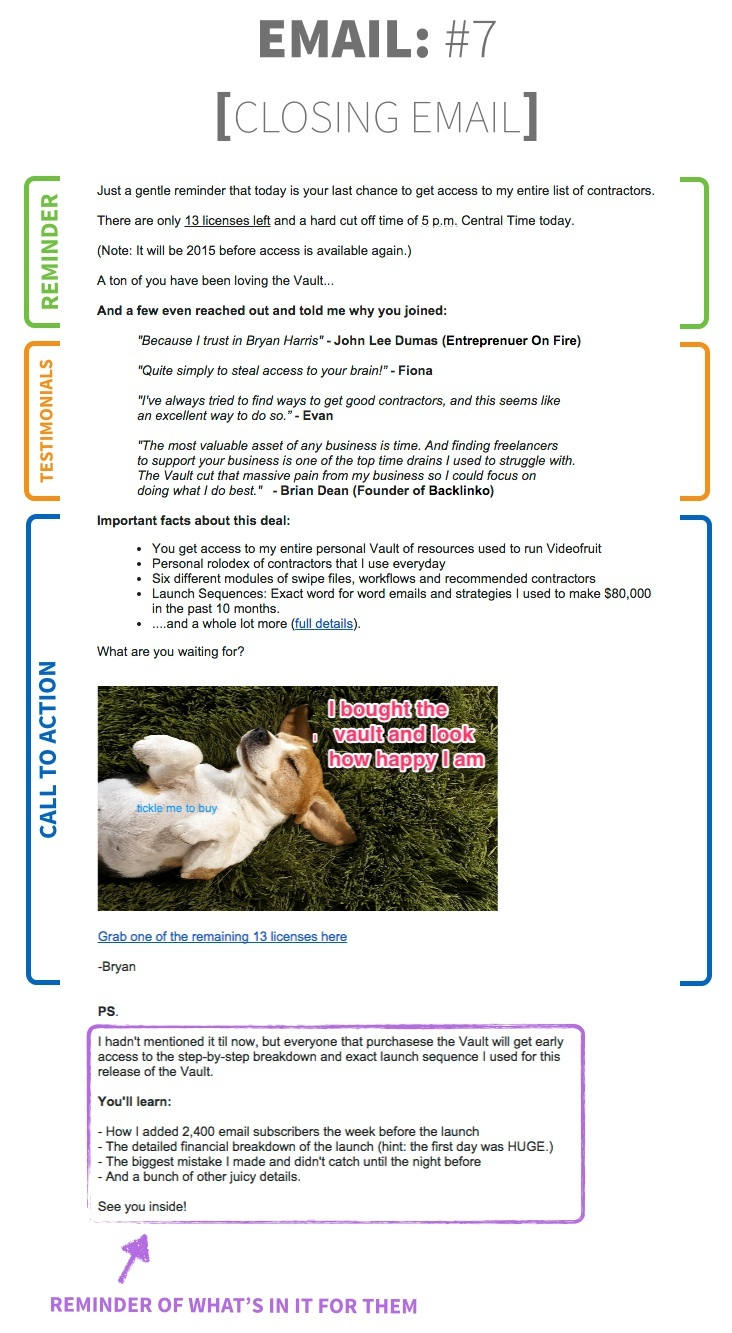
Final thoughts
You don’t need to be the next Hemingway to write high converting sales emails. You can get solid results by simply learning from other copywriters who have already written hundreds of them and take inspiration from the subject lines, styles and structures that worked best.
To get started, use proven sales sequence email frameworks like the ones I provided above and plug your personalized content into them. After doing this for a while, you will internalize the basics to be able to write something new and exciting for your audience completely from scratch.
What’s great about learning email copywriting as a skill is, you can deploy again and again to generate sales. The lifeblood of any business. And the psychological principles behind copywriting can be applied to all forms of communication. So expect to be hearing a lot more yes in all facets of your life!
thanks for the real life examples. still find it hard to create one from scratch myself. will study these more. thank u
start from the very top of the article – who are your audience? what are their paint points?
That example from Bryan Harris- man, that’s a monster! I feel like these sequences are such overkill sometimes.
Yes and no, it really depends on what you’re trying to do. Bryan Harris was building a relationship with his prospects to establish trust. So he needed all those emails to do that.
when it comes to simple sales emails….brian dean emails are super simple and he only send two of them I think, it’s not a long sequence.. maybe three.
Personalization is key in these emails… it’s funny, the tiniest change in subject line or in first sentence which has some personal details about a prospect makes a huge change
100%!
The worst is just like what you said in article – when you have your former customers or partners on the target list without realizing it. You feel so bad when they email you back.Or you have other drip campaigns running or customer service or sales rep already emailed them somehow and then you email them as well. Cleaning target lists should be something you spend a lot of time on.
well said! I have run into this many times myself. To this date I get hit up with cold sales emails from friends and partners and when I respond to them to ask them to take me off the list – they feel embarrassed.
I wonder how well these work for ecommerce selling vs. courses and digital products/software.